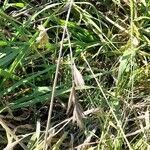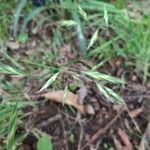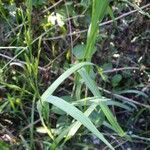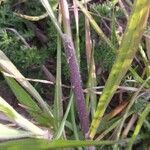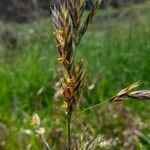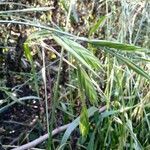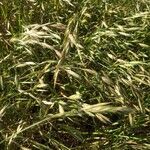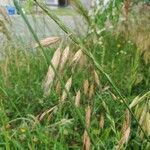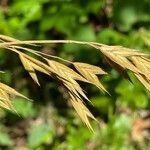Annual. Culms erect or geniculately ascending, 60–100 cm tall, ca. 5 mm in diam. Leaf sheaths pubescent; leaf blades 30–40 cm × 4–6 mm, scattered pubescent; ligule ca. 2 mm. Panicle lax, oblong in outline, 10–40 cm; branches ca. 10 cm, scabrid, each bearing 1–3 spikelets. Spikelets ovate-oblong, laterally compressed, 15–30 × 8–10 mm, florets 6–11, overlapping; rachilla internodes not visible, ca. 2 mm, scabrid; glumes narrowly lanceolate, lower glume 10–12 mm, upper glume slightly longer than lower glume; lemmas 15–20 mm, keeled, 11-veined, veins scabrid, apex mucronate; palea narrow, ca. 1/2 as long as lemma, keels ciliate. Anthers 0.3–0.6 mm. Fl. May, fr. Sep. 2n = 28, 42, 58.
Stout annual or short-lived perennial to 1 m; blades flat and broad, 3-12 mm wide; ligule 2.5-5 mm; panicles 10-30 cm, loosely contracted; spikelets (16-)20-30(-35) mm, 4-12-fld, strongly compressed; glumes lanceolate, acuminate, strongly keeled, the first 8-11.5 mm, 3-veined, the second 9-13 mm, 5-veined; lemmas 12-20 mm, keeled, closely overlapping, glabrous (at least below) between the 11-13 long-ciliate veins; awns to 2.5 mm, or none; palea half as long as the lemma; 2n=28, 42, 56. Native of S. Amer., widely cult. for forage in warm regions, and occasionally intr. or escaped in the s. part of our range, n. to N.Y. and Mo. (B. unioloides; B. willdenowii)
Tufted annual or biennial, 0.15-1.00 mm high. Leaf blade up to 400 x 8 mm; ligule an unfringed membrane. Inflorescence an open panicle, flexuous; pedicels longer than some spikelets. Spikelet 20-35 x 5-8 mm, strongly laterally compressed; glumes unequal, shorter than spikelet; lower glume 3-7-nerved; upper glume 5-9-nerved. Florets 6-many; lemma 15-25 mm long, acuminate, entire or minutely lobed, lobes < 0.5 mm long, 9-11-nerved, keeled, awnless or awn 0.5-5.0 mm long; palea much shorter than lemma, keels ciliate, glabrous in between; ovary with a conspicuous hairy appendage at apex; anther 0.5-1.0 mm long. Flowering time Oct.-Apr.
Tufted, short-lived perennial or annual 150-1000 mm high; culms erect to decumbent. Leaf blade to 400 x 8 mm. Inflorescence open, flexuous; pedicels mostly longer than spikelets. Spikelet (15) 20-35 x 5-8 mm, strongly laterally compressed; glumes and lemmas prominently keeled; lower glume 3-7(9)-nerved; upper glume 5-9(11)-nerved; lemma 15-25 mm long, minutely bifid, lobes shorter than 1 mm, apex acuminate, 9-11-nerved, awnless or awn 0.5-5.0 mm long; palea much shorter than lemma, keels ciliate; callus scar circular; anthers 0.5-1.0 mm long in cleistogamous florets, 1-5 mm long in chasmogamous florets.
Annual or short-lived perennial; up to 1 m high; tufted. Leaf blades up to 400 x 8 mm. Flowers: panicle lax; pedicels longer than spikelets; spikelets 20-35 x 5-8 mm; strongly laterally compressed; glumes and lemmas prominently keeled; acute; glumes 3-9-nerved; lemmas 15-25 mm long; keeled; minutely bifid; lobes < 0.5 mm long; awns < 3 mm long; anthers 0.5-1.0 mm long in cleistogamous florets; 2-5 mm long in chasmogamous florets.
Short-lived perennial or annual, tufted, up to 1 m high. Leaf blades 5-8 mm wide. Spikelets 20-35 mm long, 5-8 mm wide. Panicle lax, pedicels longer than spikelets; spikelets compressed; glumes and lemmas prominently keeled, acute; glumes 3-9-nerved; lemmas 15-25 mm long, minutely bifid, lobes shorter than 0.5 mm, awns shorter than 3 mm.
A tussock grass. It usually grows for 1 or 2 years. It grows about 1 m high. It forms tufts and has erect or spreading stems. The blades are narrow and flat. They are 30 cm long by 8 mm wide.
Like B. commutatus but spikelets laterally compressed, glumes and lemmas sharply keeled, lemma awns to 3 mm long.
